

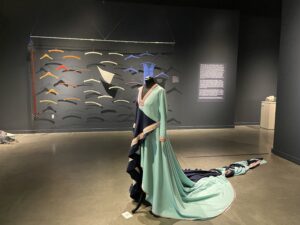
Laila Susanna Kuhmunen When Two Become One Installation with kolt traditional clothing, 2019
Finally, museums are offering us exhibitions that directly address climate change. “Arctic Highways” at the National Nordic Museum, until November 26, features twelve Indigenous artists from the circumpolar North (Sápmi, Canada, and Alaska) who address “the silent and the silenced knowledge” of their Sámi culture.
Laila Susanna Kuhmunen opens the show with her installation of a traditional kolt garment, formerly for work, not festive.
In the background is a seasonal celebration with fabrics Mátki Sámi ja Sámi áigodagaid čađa (The Roadtrip through Sápmi and the Sámi seasons) by Gudrun Guttorm. She is editor, together with Harald Gaski and Katya Garcia Antón, of Let the River Flow. An Indigenous Uprising and its Legacy in Art, Ecology and Politics (Office for Contemporary Art Norway/Valiz Amsterdam, 2020).”Let the River Flow’ takes the eco-indigenous action against the construction of a hydroelectric power plant in the Altaelva river in Northern Norway during the late 1970s and early ’80s as its starting point. The series of massive protests led by the Sámi people grew into an unexpectedly broad movement of solidarity across society, in which artists played a pivotal role.
This book reflects on events at the time and their correlations with artists’ eco-actions worldwide today. It addresses the political, cultural, and artistic aspects, including political organising, new influences of indigenous thinking on contemporary politics, and the centrality of artists within these activities.”
“Despite their protests, the Norwegian Supreme Court ruled in 1982 that the government had the right to construct the dam and power station, and the project was completed in 1987”
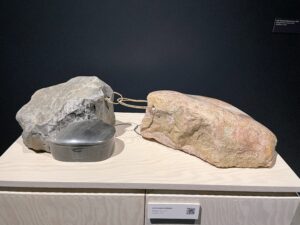
Laila Susanna Kuhmunen Steingiisá (Stone chest) Installation, stone, 2016
Laila Susanna Kuhmunen’s second work is a compelling stone sculpture from which a small polished chest emerges.
Máret Ánne Sara (below) comes from a reindeer-herding family in Kautokeino, Northern Norway, and currently works in her hometown. Sara’s work deals with the political and social issues affecting the Sámi communities in general, and the reindeer-herding communities in particular.”
But she is also involved with the international art community and showed in Documenta 14 in 2017 and will part of the Nordic Pavillion in Venice next year, which will now be a Sámi pavillion

Máret Ánne Sara (foreground) Moder Jord I (Mother Earth I) Sculpture made from a globe and scooter spring, 2015 Crowned by Foreign Fate (Background)
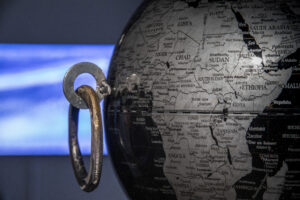
Máret Ánne Sara (detail)
![]()
“Arctic Highways” emphasizes common themes and shared concerns among Nordic cultures, beyond the artificial borders of nations. It began as an artist residency in Granö, Sweden and has now grown into a traveling exhibition and a book. The artists boldly experiment with a wide range of media, from traditional crafts to video art.
The idea of “arctic highways” creates connections between cultures: “Highways that are cultural and spiritual, real and thriving – but as invisible as the system of national borders that have imposed their rigidness and weight upon us, pitilessly trying to nullify the free flow of ideas and identity connecting our souls.” ( museum label)
Artists are from traditional reindeer herding families. They are acutely aware of the changes caused by warming weather, as well as alternative sources of energy filling open space. Wind turbines severely disrupt the grazing land of reindeer and melting snow alters migration and herding rhythms.
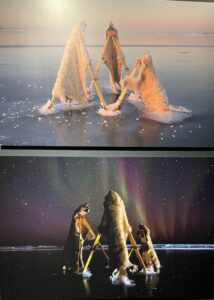
Aidainnaqduammi, Aurora Photo by Kyra Kordoski, print on aluminium
Maureen Gruber’s striking photographs of three polar bear skins titled Aidainnaqduanni (Inuvialuktun for ‘We are finally home’ ), Aurora, hanging on an abandoned survey tripod, looks like polar bears are climbing the tripods, then it becomes frighteningly clear that they are only skins. Her work here includes harp seal skin, red velvet, thread. She also works with “polar bear fur, beluga intestines and seal skins together with resins, vinyl, bubble wrap and metallic tape,” connecting the Arctic to ecological concerns.
“Throughout a week-long installation during winter freeze-up, sea ice gradually accumulated around the base of these assemblages, shifting the bears’ positions such that their gaze slowly tilted up towards the stars.”
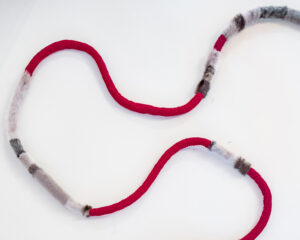
detail of Seal in Our Blood
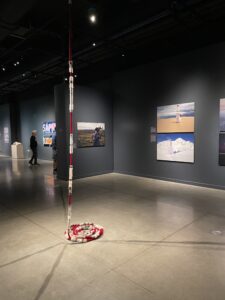
Maureen Gruben Seal in our Blood
Perhaps the most dramatic photograph in the exhibition is Meryl McMaster’s What Will I Say to the Sky and the Earth II, 2019 (in the series “As Immense as the Sky”):
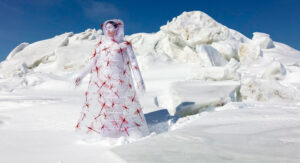
The artist stands against an Arctic landscape, wearing a protective coat with insects embedded. She states “Among the coastal ice flows of Lake Erie, I am covered by various insect species – members of a poorly understood and very important class of lifeforms. There are millions of insect species that are unknown to us, but play an important role in maintaining ecological equilibrium. To me they represent the fragile, harmonious balance that we are a part of and that we must take care to protect. Their silence is a warning that we are falling into a disharmonious condition.”
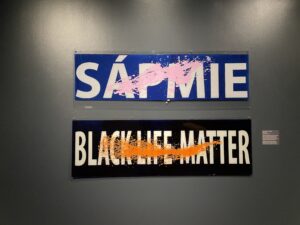
Tomas Colbengtson, Sápmi and Defaced
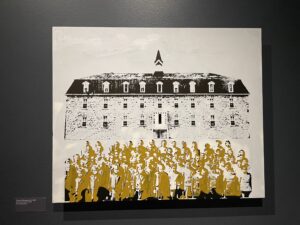
Tomas Colbengtson,Residential School
Works by Sonya Kelliher-Combs and Tomas Colbengtson address the subject of Church boarding schools in Alaska and Sweden that stripped children of their Indigenous Sámi culture. Colbengston featured in a previous exhibition at the Nordic Museum, Mygration, in whcih he collaborated with to create a moving installation about a strange project to bring reindeer and their herders to Alaska from what was then called Lapland.
https://www.artandpoliticsnow.com/2022/12/mygration/
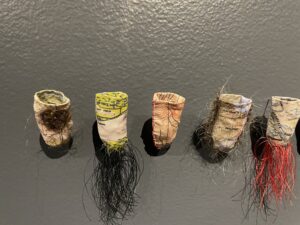
Sonya Kelliher-Combs’s Credible, Small Secrets, consists of 35 finger sized sculptures referencing abuse with human hair, nylon thread, glass beads, and steel pins. Each one refers to a village with credible reports of abuse. Colbengston’s painting is based on a photograph of a boarding school with the children lined up in front.

Laila Susanna Kuhmunen When Two Become One Installation with kolt traditional clothing, 2019
These artists of the polar North witness changes every day, as ice melts, temperatures rise, and animals and humans must change centuries old habits. The show is poignant, but also triumphant because the artists are both witnessing and resisting change.
*****************************************************
![]()
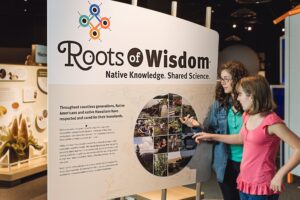
![]()
![]()
The Museum of History and Industry ( MOHAI), on Lake Union features an interactive exhibition “Roots of Wisdom : Native Knowledge, Shared Science” developed by the Oregon Museum of Science and Industry. Entirely interactive, it reaches out specifically to ages 12 – 14, but anyone can enjoy it.
![]()
“Each display highlights a different theme and tribe: “Reestablishing a Native Plant” (Eastern Band of Cherokees), “Restoring Fish Ponds,” (Hawaii), “Rediscovering Traditional Foods,” (Tulalip) and “Saving Streams and Wildlife”( Confederated Tribes of the Umatilla Reservation).
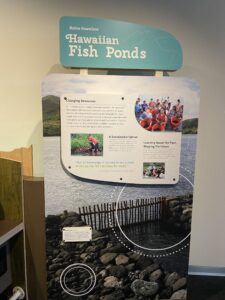
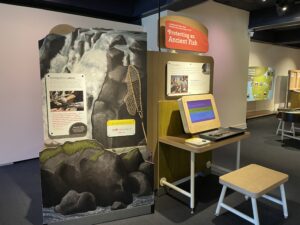
We can learn how to build a fish pond in Hawaii and or help preserve an ancient fish. The Lamprey, ( on the right) less glamorous than salmon, also suffer from the dams on the Columbia River. We can restore a river or learn why cane is better than grass near a river. We can weave a basket as we listen to traditional elders speak about caring for the land.
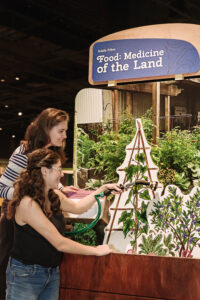
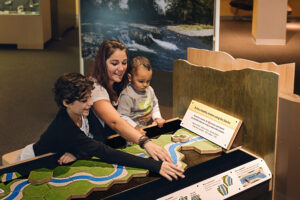
The MOHAI exhibit makes each pairing of contemporary science and indigenous knowledge easy to remember. Most striking perhaps was the section on “biopiracy” in which the question of patenting seeds is raised, a big issue in today’s world.
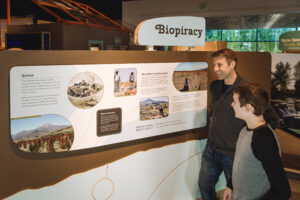
“Native Origins” suggests all the everyday products we use, like popcorn, that originally were created by Indigenous peoples.
We are fortunate to have both of these shows featuring Indigenous creative ideas that suggest a few ways to survive on the planet.